Targus USB 3.0 Dual Video Adapter Review
- You are here:
- Home
- Monitors & Display Adapters
Powered by DisplayLink's top-end silicon, the USB adapter is a great option for users looking to add multiple displays to a laptop or small form factor PC who require excellent performance and compatibility.
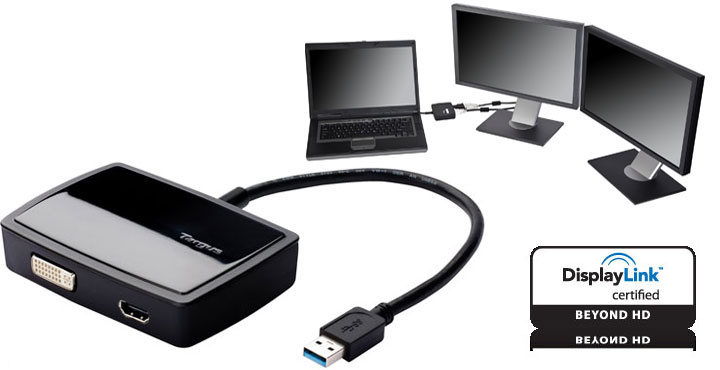
February 2012 R. Scott Clark
One of the quickest ways to boost productivity in the workplace is by adding more monitors to a workstation. It’s a simple enough task unless you’re cursed with a lack of available video ports–a plight all too common for laptops and smaller PCs. I’ll be taking an in-depth look at a USB 3.0 answer to this problem, the Targus USB 3.0 Dual Video Adapter. Showcasing DisplayLink’s latest DL-3000 series chip that’s bound to crop up in a number of USB-driven monitors, projectors, and docking stations due out later the year, will this adapter prove itself worthy of anything more than boring 2D desktop work? Read on to find out.
Contents
Dual Head Design
If there’s one thing I find frustrating in a review it’s an uninspired product name with far too many syllables. Having to type much less read aloud the proper name for Targus’ USB 3.0 Dual Video Adapter is enough to evoke a few errant twitches from my being, but thankfully this unwarranted convolution ends with the product name. The dual-headed adapter is actually quite simple in its function and appearance, sporting a utilitarian design that’s well dressed in black. Hidden beneath the glossy top panel are two blue LEDs that have a subtle glow about them, one for each video port which will light up if connected.
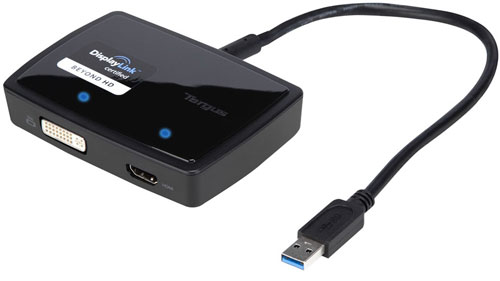
Unfortunately, the foot-long USB cable prevents the unit from resting squarely on top of my ATX computer case, though I imagine this won’t be an issue for the laptops and small form factor PCs more likely to have a need for such an adapter in the first place. Even so, it would be nice if Targus were to make use of a modular USB 3.0 port and separate cable so the adapter could be placed more freely. Assuming the adapter can reach solid ground, however, four rubber feet affixed with a strong adhesive do well to prevent the box from sliding about.
The front of the USB 3.0 Video Adapter is adorned with a single DVI-I port and an HDMI port, each clearly labeled to reduce confusion for novice users. The DVI port notably lacks screw holes for securing the cable in place, but thankfully the gap surrounding the port is tight enough that the cable is unlikely to dislodge if accidentally nudged. It’s also important to point out that both ports are wired as single-link, so only resolutions up to 2048×1152 are supported. This means that any HD television sold today and most monitors up to 24 inches will play nicely with the adapter, but larger 27″ and 30″ panels will need to be driven at a lower resolution than what they’re capable of.

Targus was generous enough to include a port adapter in the box for connecting an analog VGA display to the DVI-I port, as well as an adapter for converting the HDMI port into a DVI-D port. 3rd-party DVI-to-HDMI cables and adapters will also work if there’s a need for connecting two HDMI displays. Ultimately this setup is great for users with dual DVI, dual HDMI or mixed-interface displays, but unfortunately, Targus’ choice of a native HDMI port precludes the use of dual VGA monitors which could have otherwise been accommodated by twin DVI-I ports.
Setup and Configuration
Though installing the Targus Dual USB 3.0 Video Adapter is no more complicated than installing any other USB gadget, there exist a number of CPU and GPU system requirement caveats that differ between Windows XP and Windows Vista/7. In the cases of the latter two operating systems the DisplayLink drivers will actually hook into the graphics processor for more efficient rendering, but unfortunately, multi-GPU systems with Crossfire and SLI are known to have issues with this setup. While an overwhelming majority of computers built over the last four years ought to have no problems with the drivers, I still encourage you to take a glance at pages 5 and 6 of the DisplayLink manual so there are no unpleasant surprises. As soon as the latest drivers are installed and the display adapter is connected to any available USB 2.0/3.0 port, the embedded DL3900 firmware will automatically update itself without any user intervention. I find the upgradeable firmware particularly worthy of mention since it means that DisplayLink can roll out performance and compatibility fixes long after the product has shipped. This is of course preferable to having users find out that product flaw “X” can only be fixed by purchasing a newer piece of hardware. Already there’s been one notable fix in the last month that allows the Dual Video Adapter to be used with ASMedia-based controllers, solving the disconnect issue I was experiencing with my RocketU 1144A 4-port USB 3.0 card. 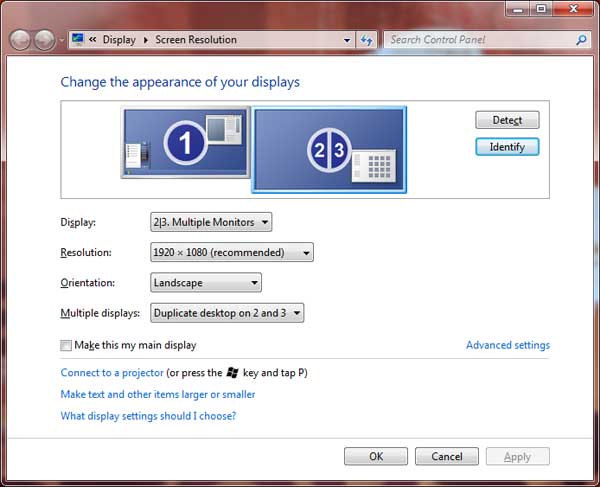
Configuring attached displays is a breeze with the dual video adapter, no different from configuring any other monitor through the Windows Display Properties. Here, displays can be repositioned and rotated at will, and the dual output displays can also be set to mirror themselves or any other connected monitor. As a much-needed improvement over older DisplayLink designs, the DVI and HDMI ports on the dual video adapter are now able to make use of EDID detection, allowing for Windows to present to users with only the resolutions that are supported by the display, and whether or not that display is even connected, to begin with. IT workers will no doubt rejoice from finally being rid of those pesky “out of range” support calls.
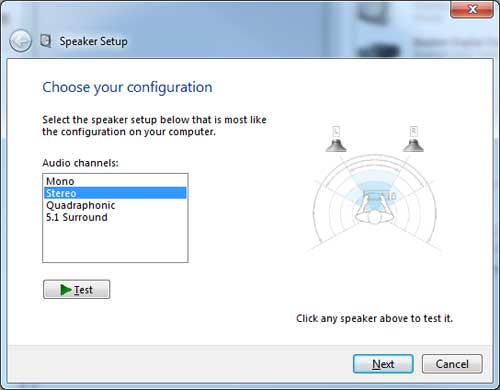
Configuring the audio output of the adapter’s native HDMI port is also a breeze – the only thing to do is set the adapter as the default playback device in Windows Sound. Audio is fixed at 16-bit 48khz (DVD quality) which provides a well-balanced mix of quality and compatibility with all applications. The DisplayLink DL-3900 chip inside the adapter allows for the configuration of up to 6 channels (5.1 surround), though in practice I’m personally only able to test two channels since my own home theater hinges on a S/PDIF cable between the television and speakers. The Dual Video Adapter may very well output 5.1 LPCM or it could be internally wired only for stereo, but I’m unable to tell either way for certain without a proper receiver. If you happen to know the answer to this please do us a favor and post it in the comments section of this review! A traditional “digital output” device like those found on some motherboards and graphics cards is nowhere to be found in the DisplayLink drivers, so Dolby Digital/AC3 and DTS 5.1 surround passthrough are unfortunately left unsupported.
Video Performance
Because DisplayLink’s drivers integrate so tightly with the existing display drivers in Vista and Windows 7, Targus’ Dual Video Adapter can effectively offload all of the heavy lifting of HD video playback and 3D rendering to the GPU. In theory, this means that if your graphics card is sufficiently able to play a game or high-def movie on a standard monitor, it can play it on the USB adapter. Of course, it then stands to reason that if your laptop’s graphics are too weak to play a game, you shouldn’t expect the USB adapter to fare any better. So how does the Targus adapter’s video performance fare in the real world? It quite simply rocks. Taking the momentous increase in bandwidth afforded by USB 3.0 and running with it, the Dual Video Adapter is able to seamlessly play a high-definition rip of District 9 at native resolution on my 1080p television. Color is nice and deep, there are no subtle compression artifacts or blocking that I could notice as there are with previous generation DL-1×5 chips, and practically zero stuttering was visible while I monitored the scrolling news tickers like a hawk.

With only one movie open in Windows Media Player, the DisplayLink drivers consumed a mere 20-30% CPU time on my dual-core, 2.53GHz Asus G72GX laptop. VLC tended to run the CPU load a bit higher but was still acceptable, and throwing up a second movie upscaled to 1080p on the second display didn’t increase the driver’s processor load above 40%. I personally have no idea why you would want to watch two different movies at the same time, but clearly, Targus’ adapter is capable of doing so. Mirroring the same movie on two screens at once also proved quite smooth.
It’s worth mentioning that the laptop powering this review is a good three years old now and doesn’t even offer native USB 3.0; I’m using an ExpressCard to do these tests. As such I’m pretty sure that any of the newer Core i5 and i7 laptops released over the last two years will do just as well if not better than my own laptop. Low-end laptops and netbooks are likely to expect some higher CPU usage, but since DisplayLink makes use of adaptive compression that adjusts dynamically with your CPU load, I’m still optimistic that the experience will be smooth.
In cases where USB 2.0 is unavoidable, the Dual Video Adapter still manages to hold its own. With the adapter hooked up to my laptop’s onboard USB, I was again able to watch District 9 at full 1080p resolution with smooth framerates. The burden of the increased compression was surprisingly little and only consumed an additional 10% CPU time over my USB 3.0 results. Video quality was partly degraded with seemingly reduced color depth and some granular blocking, but the effect was remarkably subtle compared to the older generation DisplayLink chips; I doubt anyone would notice the effect without my pointing it out to them. I didn’t want to test the playback of two separate films over USB 2.0 since that seems unnecessarily cruel, but managing dual screens over USB 2.0 for productivity worked just fine.
Movie lovers who have embraced Blu-Ray and the iTunes Store as the clear, consumer-friendly, and in no way overpriced movie platforms of the future will be heartened to know that the latest generation of DisplayLink chips provides support for High-bandwidth Digital Content Protection (HDCP). In plain English, this means you won’t be treated to error messages or a blank screen when trying to watch the latest high-definition films. Well, unless of course, you own an old or bargain-basement display to have come without HDCP, because that obviously makes you a thief who can’t be trusted, you dirty paying consumer, you. Vented frustrations and mini-rant towards Hollywood aside, I can confirm that DisplayLink’s HDCP implementation does indeed work after having tested it with the HD version of Terminator 2 on iTunes.
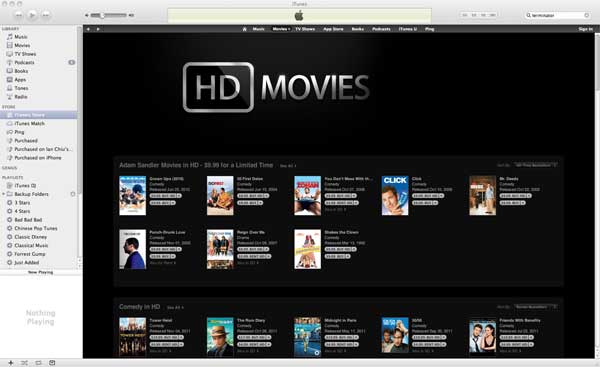
If anything, the only complaint I can levy against the Dual Video Adapter is its insufferable 24p performance. Those of you with standard 60hz televisions and monitors can safely ignore this gripe as it’s irrelevant to you, but for anyone with a 120Hz set wishing to playback Blu-Ray films at 1080p24 to avoid the 3:2 pulldown effect, you’re out of luck. 24Hz output is indeed selectable in Windows’ monitor properties, but so much stutter is introduced that the experience is unbearable. I’m unsure if this is a soft limitation of the drivers that can be improved in later patches or a fixed limitation of the DL-3900’s hardware decoder, but for now I’d only advise using the adapter in its default 60hz mode.
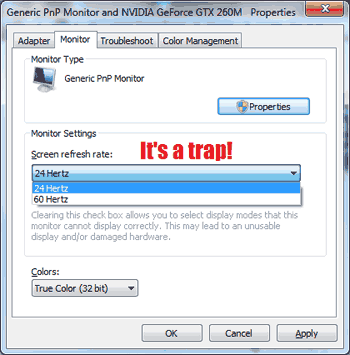
3D Performance
DisplayLink has indeed come a long way since their first DL-120 chip that I reviewed five years ago. Whereas that chip couldn’t handle anything more than the original Unreal Tournament in software rendering mode, today’s DL-3000 series is able to handle an impressive number of games that I’ve thrown at it thus far. Modern games, mind you. Audiosurf, Left 4 Dead 2, Psychonauts, Shatter, Team Fortress 2, and the Tribes Ascend open beta all ran buttery smooth on the USB 3.0 SuperSpeed Dual Video Adapter. Even Metro 2033 was able to run, and that’s one of the most demanding PC games ever released since Crysis! I’m sure there’s also something to be said here about CAD and 3D modeling applications, but those aren’t my forte. In all of these examples, I had the optimize for video option disabled in the DisplayLink drivers since the USB 3.0 interface doesn’t seem to need it, so the games had their text and graphics rendered perfectly sharp to the pixel. 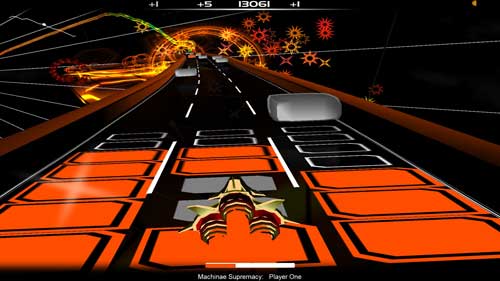
There are some guidelines to follow, however, if you want to get the most out of 3D. First, let me again reiterate that you should not expect your games to run any faster than they do on your existing GPU, since that’s what will be handling all of the renderings anyway. Second, all games must have Full-Scene Anti-Aliasing (FSAA) disabled or be run in windowed mode lest the framerate take an immediate nose dive. Finally, it’s important to keep an eye on your processor load. If the CPU pegs out at 100% which is bound to happen with more complex games, the DisplayLinkManager.exe process will be choked for resources and find itself unable to push frames to the USB adapter in a timely manner.

Owners of single and dual-core machines will need to keep the closest eyes on CPU load, but thankfully if you do end up choking for CPU time the workaround is quite easy: just lower the resolution. 1280×720 seems to work well enough for maintaining the framerate with first-person shooters. Overclocking also helps quite a bit as I found by bumping my laptop to 2.9GHz, but unless your machine supports automatic overclocking or you’re already well-versed in the dark arts, I don’t suggest giving it a try. Of course, the absolute best performance option is to run your games on a video output directly attached to your graphics card if you’re able, instead of relegating the Dual Video Adapter for keeping an eye on the forums or GameFaqs.
Recap
DisplayLink has a clear performance winner on their hands with the DL-3000 series chip, and Targus did a mighty fine job of packaging it in their easy-to-use Dual Video Adapter. HD copy-protected video playback is incredibly smooth, the dual video outputs are able to handle the extended Windows desktop and video mirroring with nary a flinch, and DisplayLink’s compatibility with the latest 3D games is mighty impressive if you have a powerful enough CPU. My two biggest concerns about the adapter are its abysmal 24p video playback and lack of a digital audio interface for AC3/DTS passthrough, but in the grand scheme of things, these are both minor and easily worked around. Retailing for approximately $99, the USB 3.0 SuperSpeed Dual Video Adapter comes highly recommended and provides excellent value for anyone looking to add multiple displays to laptops or SFF computers where installing additional graphics cards isn’t an option.
Other USB Graphics Adapters
| Preview | Product | Rating | Price | |
|---|---|---|---|---|

|
Plugable Dual Monitor Adapter for M1/M2/M3/M4 macOS Systems, Windows,... | No ratings yet |
$45.85 |
See it on Amazon |

|
OWC USB-C to Dual HDMI 4K Display Adapter with DISPLAYLINK for Apple M1 Mac... | No ratings yet |
$119.00
$94.99 |
See it on Amazon |

|
StarTech.com USB 3.0 to HDMI Adapter, 4K 30Hz UHD, USB to HDMI Display... | No ratings yet |
$74.69 |
See it on Amazon |
Pricing is last updated by Amazon on 2025-04-10 at 09:14. When you buy through Amazon affiliate links on our site, we may earn an affiliate commission.
Nexcopy manufactures a variety of PC-based and standalone USB duplicator solutions.
PC based systems support advanced USB functions such as write protection, CD-ROM partition and multi-partition creation, while standalone systems are ultra-fast, high speed USB copiers duplicating gigabytes of data quickly and accurately.

